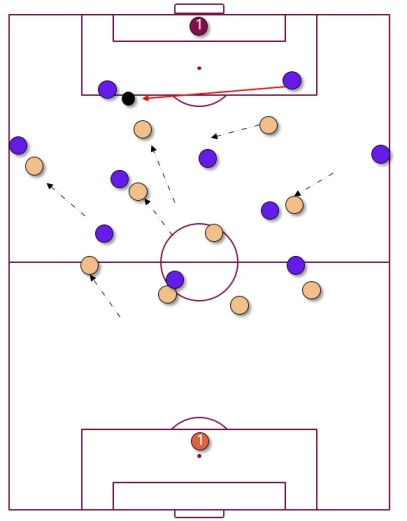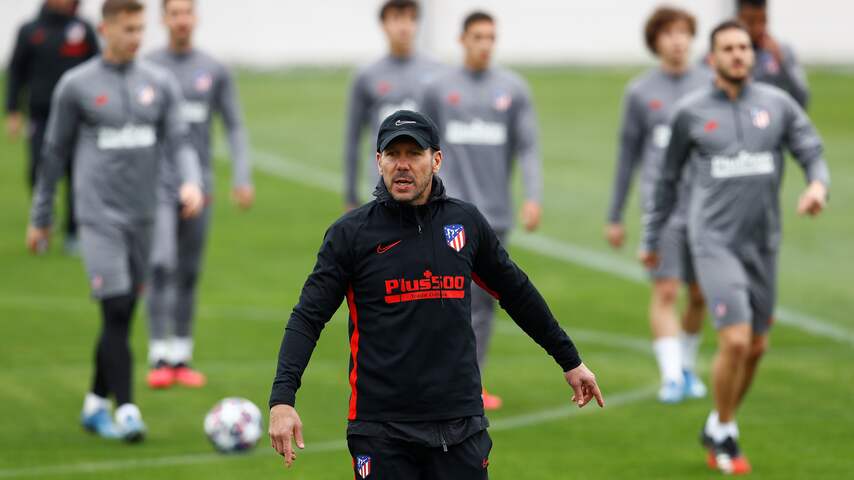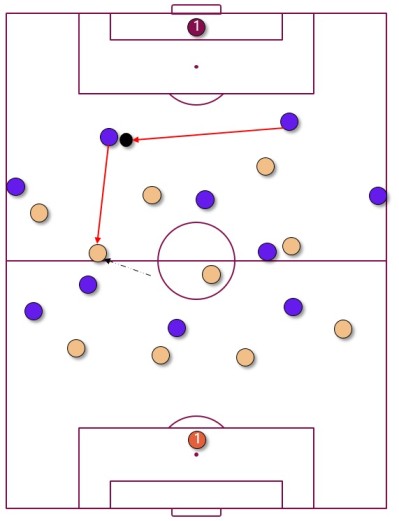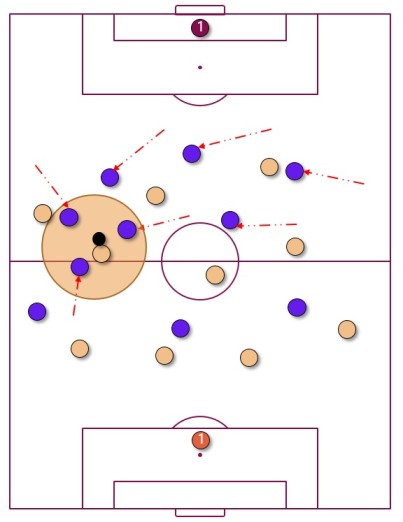Pressing in football plays a vital role in shaping the tactics of modern teams. It involves applying pressure on the opposing side during their possession, aiming to disrupt their play, force errors, or regain the ball.
Though it may appear straightforward, effective pressing can greatly influence the outcome of a match. As the game has developed, this approach has become a fundamental pressing strategy for many successful teams.
Why is pressing so important in today’s football?
It disrupts the opponent’s flow, enables quicker ball recovery, and opens up attacking possibilities. Teams that execute pressing efficiently often control the tempo of the game, pushing their opponents out of their comfort zone.
Table of Contents
The Fundamentals of Pressing
Definition and Basic Principles
Pressing in football is essentially the strategy of closing down opponents in a fast and aggressive way when they have the ball, with the objective of either forcing a turnover or limiting their ability to make effective passes or dribble forward. Pressing requires high intensity, excellent team coordination, and tactical discipline.
The basic principles of pressing are as follows:
- Pressure: Players press their opponents as soon as the ball is lost – defensive transition – or zonal pressing when the ball is pressed when an opponent receives it in a specific zone.
- Closing down passing lanes: Pressing players not only try to press but also block potential passing lines while they are running toward the opponent.
- Compactness: The team remains tight and compact, minimising space for the opposition to exploit. The pressing is done in a cohesive way to keep the players close and always have defensive cover.
Types of Pressing: High Press, Mid Block, and Low Block
- High Press: This is when a team presses aggressively high up the pitch, often in the opponent’s half. The aim is to win the ball in dangerous areas quickly and create goal scoring opportunities with less distance to cover.
- Mid Block: Teams adopt a more conservative pressing style, setting up in near the half line but still applying pressure on the ball carrier when enter in certain areas of the pitch.
- Low Block: The team drops deep, giving the opponent more space but focusing on blocking key attacking zones, protecting the area where the most goals are scored, the penalty box.

The above screenshot presents a high pressing in a 4 – 4 – 2. The behavior is collective. One forward jumps on the ball carrier while the near defenders press higher to block near passing options.
How Pressing Works in Football
The Mechanics of Pressing
Pressing in football goes beyond simply chasing the player with the ball. It involves the entire team working in unison, with each movement carefully planned. When one player steps forward to apply pressure, their teammates must adjust by filling the gaps and anticipating passing lanes. Successful pressing is based on strong communication and the ability to foresee the opponent’s intentions.
Pressing as a Team Tactic
While individual pressing is important, pressing is a team effort. When a player jumps to press, the rest of the team must also position themselves to restrict the passing options for the opponent. This creates a high level of pressure that makes it difficult for the opponent to play out from the pressure.
Pressing and Counter-Pressing
Pressing and counter-attacking are often linked, but they are different football tactics. Pressing focuses on winning the ball while being in a defensive formation. On the other hand counter-pressing, is about immediate applying pressure and reduce space once the ball is lost. Many teams use pressing or counter-pressing to create counter-attacking opportunities, making it a highly effective strategy.
Why Pressing is Key to Modern Football
Over the years, pressing has become a core tactical element, particularly in European Football. What started as a basic defensive strategy has evolved into a highly organized and sophisticated system. Teams like Liverpool, under Jurgen Klopp and Athletic Madrid, under Diego Simeone Atletico, are bright examples on how being excellent in pressing situations can turn a team from good to champions.
In leagues such as the Premier League and La Liga, pressing is a fundamental tactic. Teams that press effectively can prevent their opponents from establishing rhythm and dominating possession, which is key to success in these high-paced leagues.

Key Principles for Effective Pressing
Pressing in football isn’t just about chasing the ball – it demands a unique kind of player with a mix of physical, tactical, and mental strengths. These are the essential traits of an effective pressing player:
- Endurance – Pressing is relentless. Players must have exceptional fitness and stamina to sustain high-intensity efforts throughout the game. The ability to press repeatedly without fading is crucial.
- Aggression – Pressing requires a strong, aggressive mindset. Players need the drive to chase down opponents and the willingness to fight for possession. However, blind aggression can lead to fouls or positional errors, so smart, controlled aggression is vital.
- Tactical Intelligence – The best pressing players don’t just run everywhere without a reason. They read the game, anticipate passes, and press at the right moment. Tactical awareness allows them to cut passing lanes, force mistakes, and know when to hold their position instead of over-committing.
- Mentality and Focus – Pressing is as much a mental game as it is physical. Players must stay focused and maintain high energy levels even when fatigued. A strong mentality ensures players stay disciplined, resilient, and persistent, especially during tough phases of the match.
A combination of these traits allows pressing players to be effective without compromising their team’s defensive shape.
Pressing Systems and Formations
The 4-3-3 formation is one of the most popular systems for pressing, as it allows for an organized yet dynamic press having balanced distances in the whole pitch. The three forwards can apply pressure on the opposition’s defenders and midfielders, while the three midfielders support the press and block passing lanes.
While the 4-4-2 system can be effective in zonal defending mostly in a middle block, the 4-3-3 formation often provides more flexibility in pressing, allowing the wide attackers to press high while maintaining midfield solidity.
Different formations will show how a team presses, which pressing trigger it use and which area prioritizes to recover the ball. Teams that want to press high or setting a pressing trap to the flanks need to ensure their formation is compact closing near passing options that will allow the opposing team to get out of the pressure.
The Benefits of Pressing in Football
Disrupting the Opposition’s Play
The primary benefit of pressing in football is that it disrupts the opponent’s play. By forcing mistakes such as a bad pass, a wrong ball receiving or dribble, pressing teams can control the tempo of the game and break up the opponent’s rhythm.
Pressing in advanced areas forces an opposition player to play long balls or risky passes, which can be intercepted by defenders or midfielders, regaining possession and maintaining control.
Creating Quick Attacking Opportunities
Winning the ball, especially in advanced areas, allows a team to exploit the opposition’s lack of structure right away. This often results in fast counter-attacks and goal-scoring opportunities. It tends to work well against teams that prefer building play from their defensive third.
Keep opponent away from own goal
Pressing high up the pitch keeps the opposition far from dangerous areas near your own goal. By applying pressure early, teams can force their opponents to play in their own half, limiting their ability to build meaningful attacks. This reduces the number of threats to the defensive line and minimizes the risk of conceding goals.
The Risks and Downsides of Pressing
- Over-committing and Leaving Space Behind: One of the risks of pressing in football, especially without a cohesive way, is leaving gaps behind the defense. If a pressing team is caught out of position, the opposition can exploit the space and create goal-scoring opportunities.
- Fatigue and Tactical Errors: Continuous pressing is physically demanding, and players can tire quickly, especially if they press for extended periods. Fatigue can lead to tactical errors, leaving the team vulnerable to counter-attacks.
- Pressing Against Teams Good in Possession: Teams with exceptional ball control, like Manchester City, Arsenal, Bayern Leverkusen, Man Utd with Ruben Amorim or Barcelona, can pass their way out of a press. Against such teams, pressing can become ineffective and lead to a higher risk of conceding goals.
Pressing in Different Football Cultures
The German “Gegenpressing” Philosophy
In Germany, Gegenpressing (counter-pressing) is a hallmark of their footballing culture. Teams like Borussia Dortmund, under Jurgen Klopp and Bayern Munich, under Jupp Heynckes, have excelled using this aggressive pressing style, which focuses on immediately winning the ball after losing it.


The above screenshots shows a fast reaction to win the ball back as soon as the ball is lost.
The Spanish Tiki-Taka and Its Connection with Pressing
While Tiki-Taka focuses on possession and passing, it often involves a form of counter-pressing in the middle or final third to quickly regain possession. Teams with high possession percentages must adopt this approach because having players positioned high up the pitch to maintain ball control increases the risk of counterattacks through passes played behind their defensive lines.
How to Improve Pressing as a Team
- Communication and Coordination: Successful pressing in football relies heavily on players staying in sync and communicating consistently. Knowing when to apply pressure and when to hold position is crucial, and this can be developed through tactical drills and open lines of communication within the team.
- Timing and Anticipation in Pressing: Pressing isn’t simply about chasing the ball—it’s about pressing with precision. Players need to read the game, predict the opponent’s next move, and engage at the right moment to create errors and recover possession.
- Training Drills for Effective Pressing: Coaches implement small-sided games, positional play, and possession drills to enhance pressing efficiency. These football drills sharpen team coordination, teach players how to compress space, and reinforce the importance of regaining the ball swiftly.
The Role of the Coach in Pressing
How Coaches Train Pressing Tactics
Coaches like Jürgen Klopp, Marcelo Bielsa and Pep Guardiola are known for their pressing tactics. They implement pressing drills and ensure that players understand their roles in the system.
Special mention must be done about the work of Ralf Rangnick with RB Leipzig as a manager and later on as a global sport director. He help shaping the club’s identity and tactical direction as a high energy team with fast pace football and intense pressure behavior.
Arrigo Sacchi is often seen as one of the pioneers of the aggressive press in football, transforming how teams approached both defense and attack. His tactics emphasized relentless pressure on the ball, forcing mistakes and winning possession high up the pitch, closer to the opponent’s goal.
Sacchi’s influence extended to the international stage, where his Italy side in the World Cup showcased an attacking team built on pressing and quick transitions. His innovative style not only redefined defensive organization but also set the foundation for the high-intensity pressing seen in modern football.
Famous Coaches Known for Implementing Pressing
- Jürgen Klopp: Famous for his “heavy metal football,” Klopp’s teams are known for their intense, high pressing.
- Pep Guardiola: While Guardiola’s teams are known for possession, they also implement a form of pressing to win the ball back quickly.
- Marcelo Bielsa: Bielsa’s Murderball drill is an intense, nonstop training game focused on high-pressing, fast transitions, and relentless physical and mental effort to simulate real match conditions
Conclusion
Pressing is a crucial strategy in today’s modern football, capable of unsettling opponents, opening up chances in attack, and providing teams with a significant advantage. Though it carries certain risks, the rewards of effective pressing are clear. For teams aiming to control the game and outperform their rivals, developing strong pressing techniques is a key component of success.
FAQs
- What is pressing in football? Pressing is a tactic where players apply pressure to the opponent when they have possession of the ball, aiming to force them into mistakes and regain possession quickly.
- What are the different types of pressing? There are three main types of pressing: high press, mid press, and low press. Each type is used based on the team’s tactics and the game situation.
- How can a team improve its pressing? Teams can improve pressing by focusing on communication, timing, anticipation, and executing tactical drills that emphasize team coordination.
- Who are some of the best pressing players? Players like Mohamed Salah and N’Golo Kanté are known for their exceptional pressing abilities.
- What are the risks of pressing? Pressing can lead to leaving space behind, fatigue, and vulnerability to counter-attacks, especially against teams with excellent ball control.


[…] most dominant football teams in Europe thanks to Klopp’s emphasis on togetherness, relentless pressing, and faith in his players’ […]